NOTE: This Blog post has been edited and updated a few times (latest 03/03/20) since it’s original posting. There will be another post in the future, with information gathered since, which is not below.
As mentioned earlier. We are coming back to the “Prologue” to the “Canonical Epistles” in the Codex Fuldensis.
( F ) = Codex Fuldensis, (circa. 6th century C.E.), officially known as Hessian State Library, Codex Bonifatianus I, also known as the: “Victor Codex.” A Latin Vulgate New Testament manuscript.
Folios 443r, Page 869, 443v, Page 870, 434r, Page 871 = “Epistulae Canonice Prologus.”
Folio 463r, Page 929 = 1st John 5:7-8, Comma-J excluded.
I think I’ve discovered something, that I really want to share with you. It’s in regards to a passage about the Comma Johanneum mentioned within the “Catholic Epistles” Prologue, generally attributed to the Pseudo-works of Jerome in the Codex Fuldensis.
First images of the Prologue from the manuscript itself.
[ “Inc Epistulae Canonice Inc Prologus” ] Prologue to the Canonical Epistles begins on Folio 869:443r
https://fuldig.hs-fulda.de/viewer/image/PPN325289808/869/
Continues on Folio 870:433v
https://fuldig.hs-fulda.de/viewer/image/PPN325289808/870/
Ends on Folio 871:434r
https://fuldig.hs-fulda.de/viewer/object/PPN325289808/871/
Below are two paged images, single-page images, then a zoomed-in image of the main text of the Prologue:
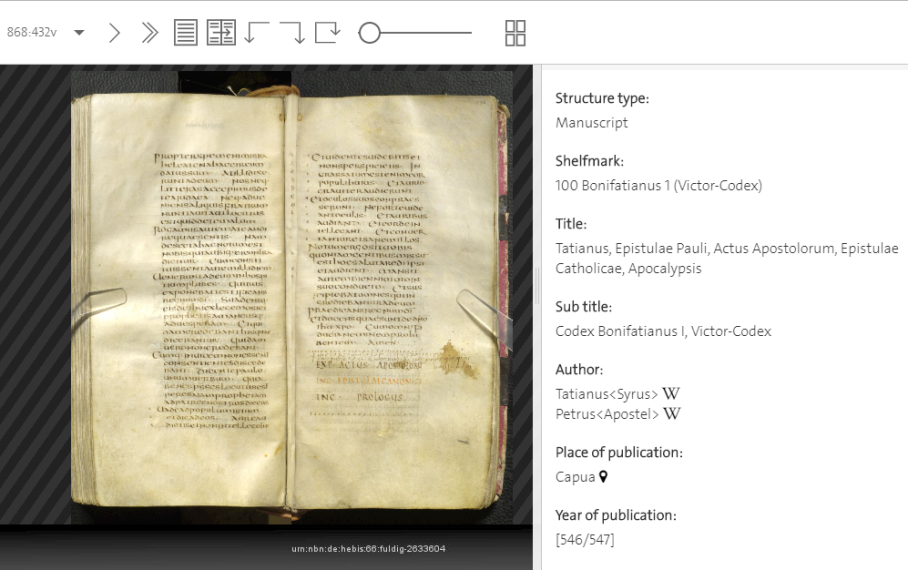
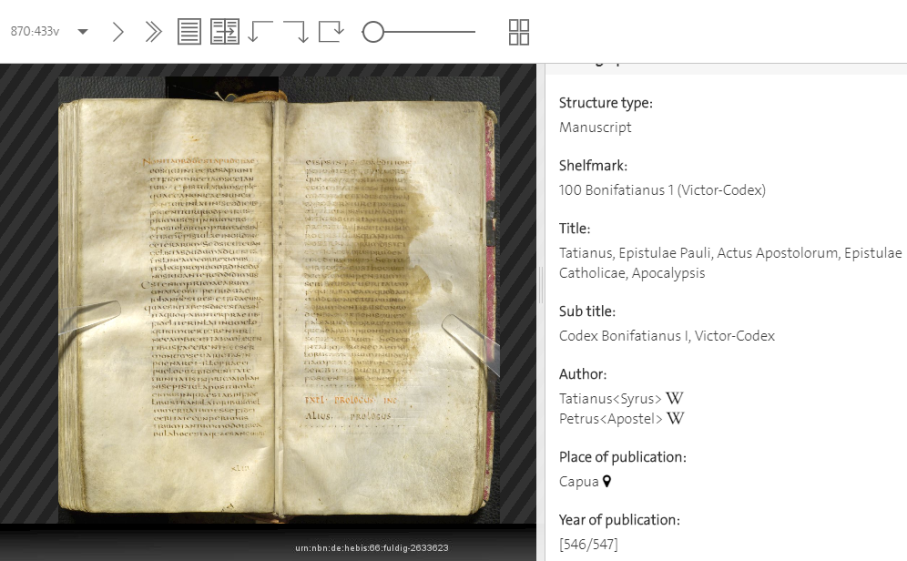
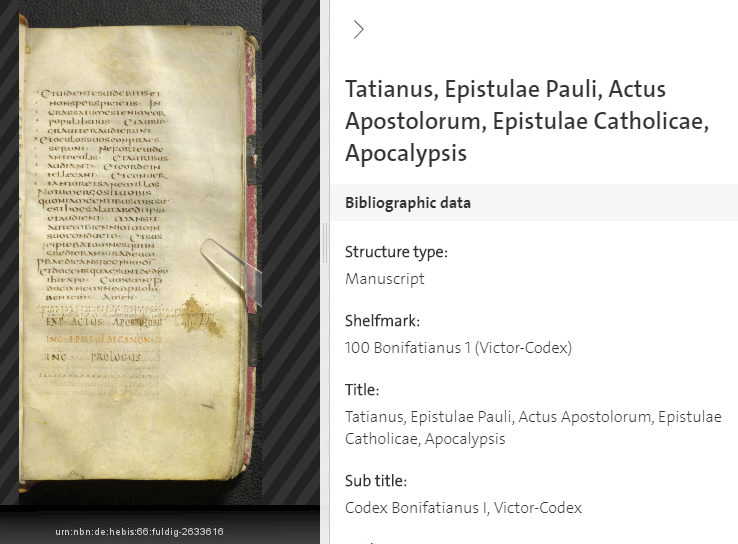
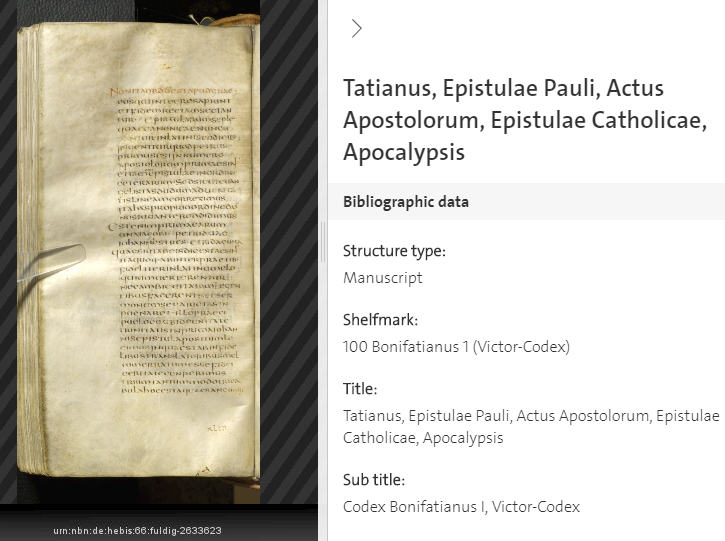
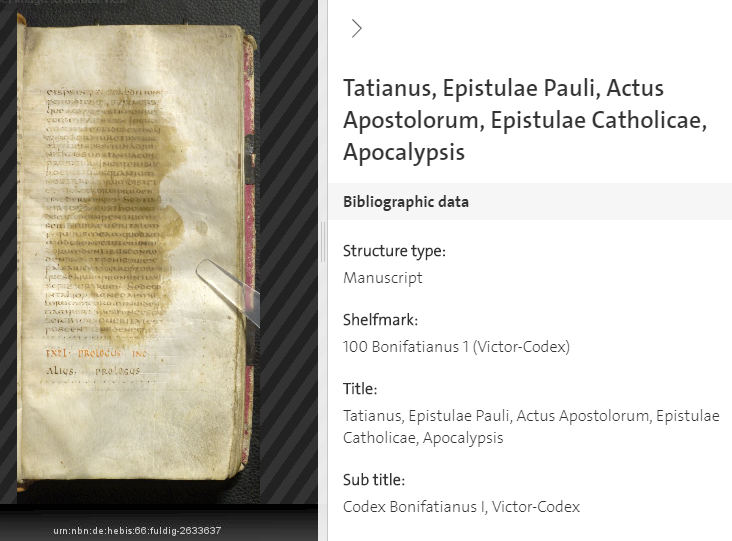
The main text of the Prologue without the title heading:
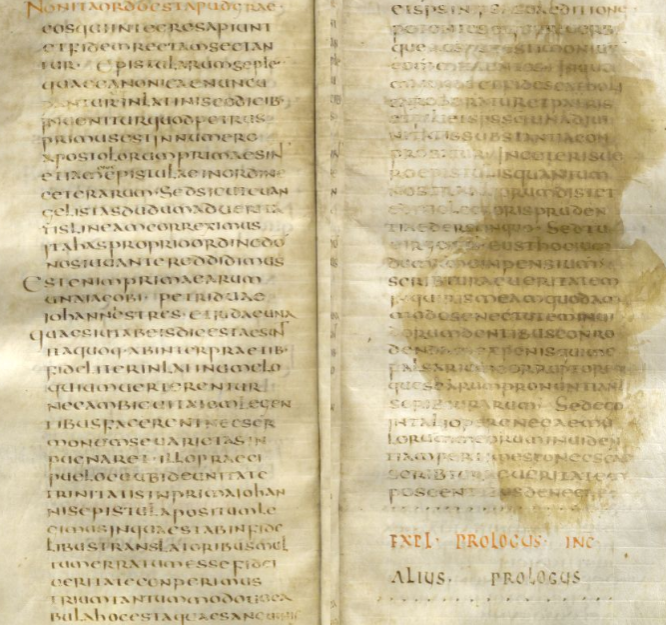
Now, let’s take a closer look at what’s in the Latin text.
First the heading to the Prologue, “Epistulae Canonice Prologus” which is believed to be (with degrees of certainty) a handwritten note from Victor Caupa himself:
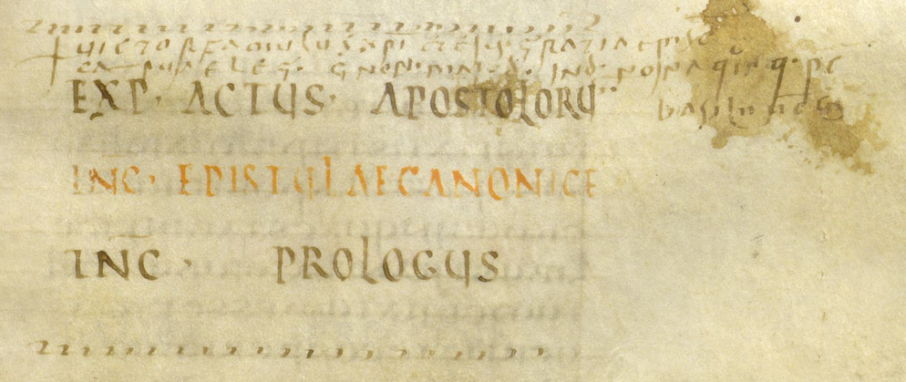
Now here’s the same image with Ernst Franke’s Latin transcription above:

Codex Fuldensis: Novum Testamentum latine interprete Hieronymo By Ernst Ranke (1868) = Prologue Pages 398-399:
https://archive.org/details/codexfuldensisn00rankgoog/page/n430
Now let’s have a close up look at the Prologue text.
Page 1 of the Prologue, Folio 433v:
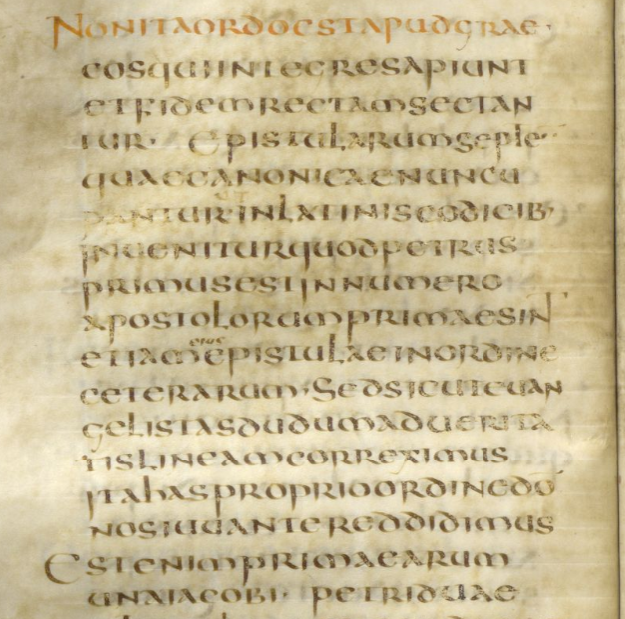
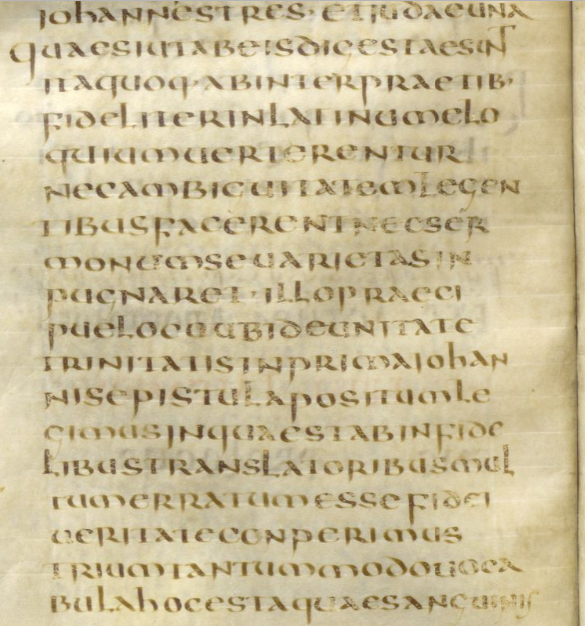
Page 2 of the Prologue, Folio 434r:
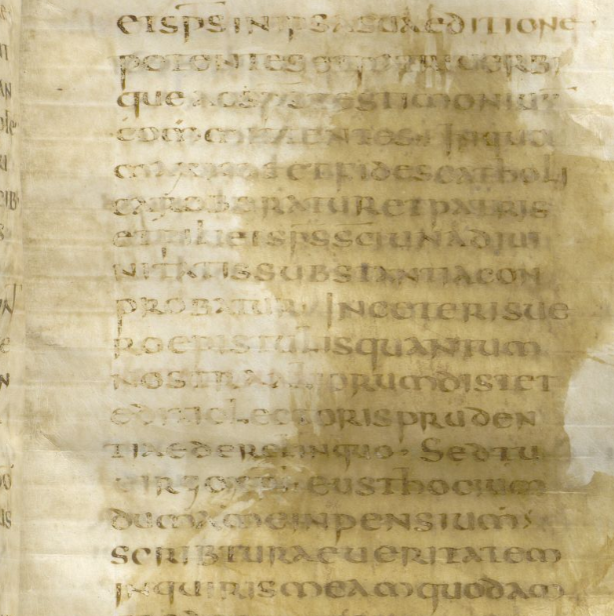
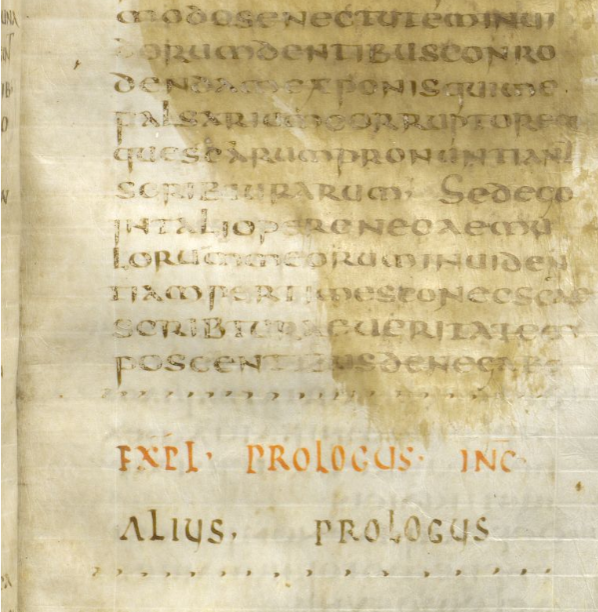
For reference and comparison, here are some key printed texts of the Prologue below.
PLEASE NOTE: At this date, I’m waiting for the critical text of the Stuttgart Vulgate to arrive from a friend. Hopefully, if it contains the text of the Prologue and a critical apparatus, I will add it later to this post. [UPDATE (03/03/20) there are other even more detailed (and important) printed texts that have been kindly pointed out to me by Hugh Houghton, that will be part of, and the subject of another post.].
Ernst Ranke’s text:
Codex Fuldensis: Novum Testamentum latine interprete Hieronymo By Ernst Ranke (1868) = Prologue Pages 398-399:
https://archive.org/details/codexfuldensisn00rankgoog/page/n430
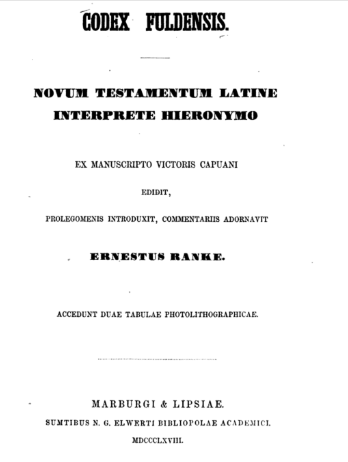

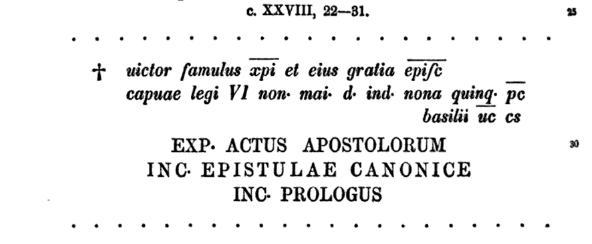
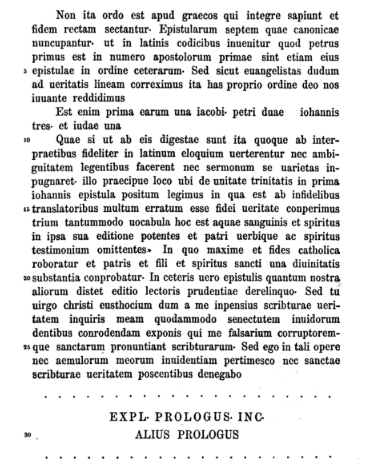
Migne’s text:
MPL, Vol. 29, Col. 865-874
https://archive.org/details/patrologiaecurs121unkngoog/page/n433


Chapman’s text:
Notes on the Early History of the Vulgate Gospels,” By J. Chapman (1908) = Prologue Pages 262-263:
https://archive.org/details/NotesOnTheEarlyHistoryOfTheVulgate/page/n278
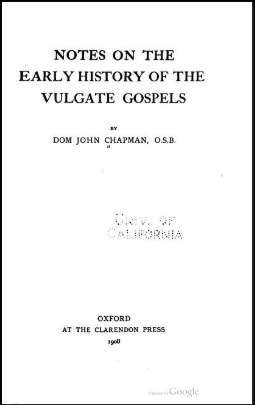


Now going back quite a bit, here’s an older printed text of the Prologue, which will become relevant later in the post.
Complutensian Polyglot 1514-1517
https://en.wikipedia.org/wiki/Complutensian_Polyglot_Bible

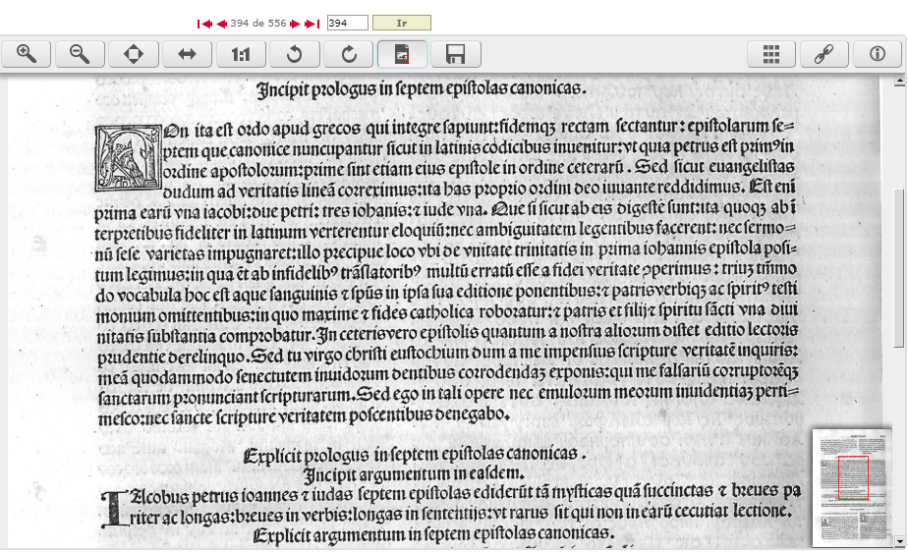
So you may be asking: What’s so remarkable about that?
We know what the Prologue says in the Codex Fuldensis about the Comma Johanneum! – Don’t we? It says that unfaithful translators “omitted” the Comma!
Right!
Wrong!
Ranke (published 1868), Migne (MPL volumes published 1856-61), and Chapman’s (published 1908) text’s have all been wrong for over a hundred years on one crucial word!
What’s that? = Latin: “omittentes”, in the phrase: “testimonium omittentes”.
Ranke (Page 399):

Migne (Vol. 29, Col. 872-873):

Chapman (Page 263):
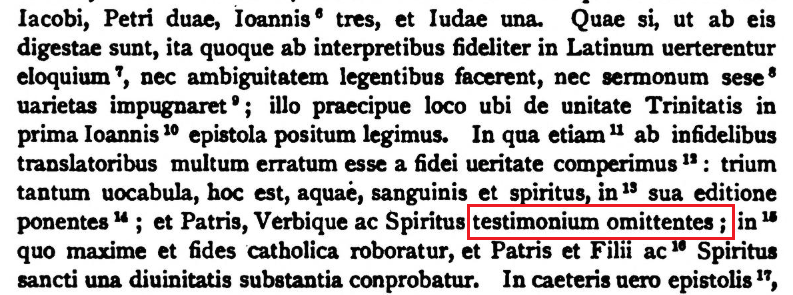
What I think I’ve discovered (and I must say I’m flabbergasted that no one appears to have noticed this) which has no reference in any literature whatsoever (at least – that I’m aware of) is that: “testimonium omittentes” is not what the Codex Fuldensis actually says in that particular sentence, in that particular phrase!
So, what does that Codex really say?
See for yourself.
Here’s a close up look at Page 2 of the Prologue’s main text, Folio 434r, looking at the beginning of the fourth line from the top, on the left hand side:
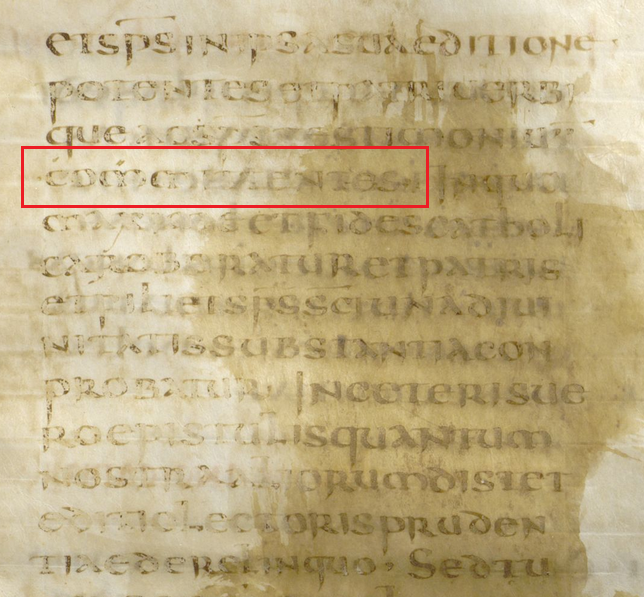
A little closer yet again:

Notice the difference?
Does it say: “omittentes” with a single “m” and beginning with an “o”?
No, it doesn’t!
It says:


It says, Latin: “committentes”! (Plural, present, active, participle of Latin “committo”). Beginning with a: “c” and a double: “m”.
There’s more:
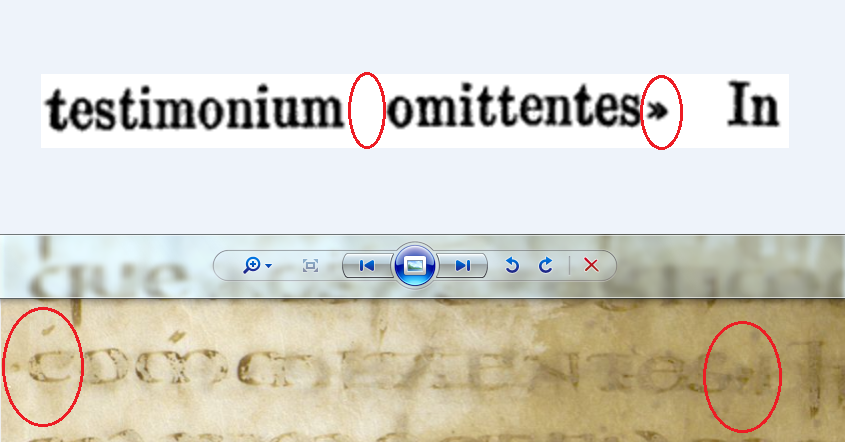
It’s followed by a Scribal mark of some sort.
It’s faded, but visible when zoomed in on (Ernst Ranke picked up on it!).
It is also followed by a larger sized “I” (the text is all in uncial script) in the phrase: “In quo” which follows.
Does “In quo” begin a new sentence? Therefore a separate thought by the author (whoever that may have been)? I don’t know for certain, but it seems some sort of thought break/change is indicated.

In the English translations below (with the exception of Wordsworth), there appears to be no sentence break or thought change here (as is indicated clearly in the manuscript). They take the two separate sentences as one continuous sentence.
Here are four examples in English:
“In this I found translators (or copyists) widely deviating from the truth; who set down in their own edition the names only of the three witnesses, that is, the Water, Blood, and Spirit; but omit the testimony of the Father, the Word, and the Holy Spirit; by which, above all places, the Divinity of the father, the Son, and the Holy Spirit is proved to be one.” – (Ben David, trans., 1826)
“Indeed, it has come to our notice that in this letter some unfaithful translators have gone far astray from the truth of the faith, for in their edition they provide just the words for three [witnesses]—namely water, blood and spirit—and omit the testimony of the Father, the Word and the Spirit, by which the Catholic faith is especially strengthened, and proof is tendered of the single substance of divinity possessed by Father, Son and Holy Spirit.” – (Wordsworth, White and Sparks, trans., 1889-1954)
“In which we find many things to be mistaken of the truth of the faith by the unfaithful translators, who put down in their own edition only three words, that is, Water, Blood, and Spirit, and who omit the witness of the Father and Word and Spirit, by which both the Catholic faith is greatly strengthened and also the one substance of the Divinity of the Father and of the Son and of the Holy Spirit is proved.” – (Kevin Edgecome, trans., 2006)
“Just as these are properly understood and so translated faithfully by interpreters into Latin without leaving ambiguity for the readers nor [allowing] the variety of genres to conflict, especially in that text where we read the unity of the trinity is placed in the first letter of John, where much error has occurred at the hands of unfaithful translators contrary to the truth of faith, who have kept just the three words water, blood and spirit in this edition omitting mention of Father, Word and Spirit in which especially the catholic faith is strengthened and the unity of substance of Father, Son and Holy Spirit is attested.” – (Thomas Caldwell, trans., 2010)
Download OpenOffice Word processor file with parallel Latin texts of Ranke, Migne, Chapman alongside four English translations from the link below:
All have one continuous sentence.
Such translators (IMO) were just following the printed editions of the text (mostly Ernst Ranke). So, we should give them the benefit of the doubt. They did this in good faith. So, I don’t blame them at all.
So what does all this mean?
What’s the big deal?
Well, the English translations, upon which the majority of people rely on to make an informed decision about the Comma Johanneum (from now on CJ) are not as accurate as they could be (Jerome himself might possibly say: “unfaithful” to the text – at least in this particular part of the text). They do not fully convey the very original sense of the Fuldensis text (which is the principal manuscript for Latin critical texts).
NOTE TO THE TRANSLATORS: This is not a personal criticism of the translators’ work. Most of them are a good translation of the texts they had available. According to my research, limited knowledge, and resources, it appears that not even Erasmus, or Sir Issac Newton (in his famous work: “Two Notable Corruptions of Scripture”) were aware of this reading. This makes for a new area of research that shows the Latin text (with the flow-on effect to the English texts) need’s revising (IMO).
The sense intended by the original author has therefore been obscured by later Scribal interference!
So the question needs to be asked, if: “testimoniu[m] committentes” was the original reading instead of: “testimoniu[m] omittentes,” then what does this part of the Prologue really mean?
One thing is certain according to the original text – it does not actually say in Latin: “omit” or “omitting”! And that’s a big deal when it comes to the Comma Johanneum!
But if only that was all there was to it!
If only it was a single variant in the Codex Fuldensis.
It isn’t.
It goes much deeper than this. It’s by no means a single variant in an isolated manuscript.
What I have found (just so far) in my research shows, that (IMO at least) Latin: “committentes” was most likely the original reading of the Canonical Epistles Vulgate Prologue (from now on CE-Vul-Prol, or CE-Prol), not: “omittentes”, and that (like the CJ itself) there is a clear pattern that emerges in the Vulgate MSS of tampering and erasure of the original reading.
Here are some examples of tampering and erasure of the original reading, that I’ve found so far.
Please note that not all Vulgate MSS have a CE-Prol in them. Also, there are no known Vulgate MSS (known to still exist) that have the CE-Prol in them dating from the Seventh-century C.E.
So, let’s have a look at MSS from the 8th-century onwards.
8th century C.E. Vulgate Manuscripts
BnF Latin ms. 8847 (circa 8th-9th century A.D.)
Folio 144r = Prologue (Anonymous) reads: “omittentes” with “c” and the second: “m” erased, but still visible.
https://gallica.bnf.fr/ark:/12148/btv1b8438679t/f297.item.zoom



Folio 148r = 1 John 5:7-8, no Comma J.
https://gallica.bnf.fr/ark:/12148/btv1b8438679t/f305.item.zoom
BnF, Latin ms. 11505 (circa 8th-9th century A.D.)
Folio 206r = Prologue (Anonymous) reads: “omittentes” with “c” erased, but still visible.
https://gallica.bnf.fr/ark:/12148/btv1b8426780x/f417.item.zoom




Folio 211v = 1 John 5:7-8, no Comma J.
https://gallica.bnf.fr/ark:/12148/btv1b8426780x/f428.item.zoom
BnF Latin ms. 9380 [Codex Theodulphianus] (circa 8th-9th century A.D.)
NOTE: This a revision of the Vulgate.
Folio 305r = Prologue (Anonymous), reads: “testimonium omittentes” with two dots above “o” in “omittentes” where “c” would be. This might show the Scribe was aware of the reading (or it could be merely coincidental).
https://gallica.bnf.fr/ark:/12148/btv1b8452776m/f615.image.r=Latin%209380


Folio 308r = 1 John 5:7, is Comma-J inclusive. Text reads: “Filius” instead of “Verbum”.
http://gallica.bnf.fr/ark:/12148/btv1b8452776m/f621.item.r=Latin%209380.zoom
Rome, Biblioteca Vallicelliana B.25II [Codex Iuvenianus, Codex Vallicellianus] (circa. 8th-9th century A.D.)
Folio 45r = Prologue (Anonymous). This manuscript definitely has a marginal Notae right beside: “omittentes”.
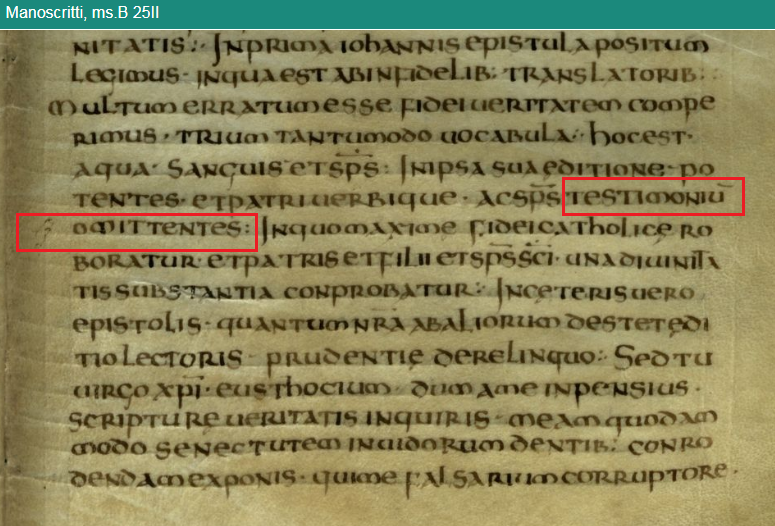


Folio 58v = 1 John begins
Folio 62r-62v = 1 John 5:7-8, no Comma-J.
9th century C.E. Manuscripts
St Gall, Stiftsbibliothek, 75 (circa. 9th century A.D.)
Folio 769 = Prologue (Anonymous) reads: “omittentes” with “c” erased, but still visible.
https://www.e-codices.unifr.ch/en/csg/0075/769



Folio 778 = 1st John 5:7-8, no Comma J.
https://www.e-codices.unifr.ch/en/csg/0075/778
London, British Library, MS Add. 10546, (circa. 9th century A.D.)
Folios 402r-403v = Prologue (Anonymous) reads: “committentes”. No signs of tampering.
https://www.bl.uk/manuscripts/Viewer.aspx?ref=add_ms_10546_f001r



Folio 406v = 1 John begins
https://www.bl.uk/manuscripts/Viewer.aspx?ref=add_ms_10546_f001r
Folio 407r = 1 John 5:7-8, no Comma-J.
https://www.bl.uk/manuscripts/Viewer.aspx?ref=add_ms_10546_f001r
London, British Library, MS Add. 11852 [Codex Ulmensis] (circa 9th century A.D.)
http://www.stgallplan.org/stgallmss/viewItem.do?ark=p21198-zz002971c4
NOTE: This is possibly a Hartmut revision of the Vulgate.
Folio 168v = Prologue number one (Anonymous), incomplete.
Folio 169r = Prologue two (attrib. Jerome) begins.
Folio 169v = Prologue two continues over page and reads: “omitentes” (single: “m” single: “t”) with the “c” still visible but erased.


Folio 183v = 1 John begins
Folio 187v = 1 John 5:7-8, has Comma-J with the comparative variant of: “Sicut in caelo tres sunt” (“just like/as there is/are three in heaven” etc).
London, British Library, MS Add. 24142 (circa 9th-10th century A.D.)
NOTE: This is a revision by Theodolf of the Vulgate.
Folio 247r-247v = Prologue (Anonymous) reads “omittentes” with no signs of tampering.
http://www.bl.uk/manuscripts/Viewer.aspx?ref=add_ms_24142_f247r
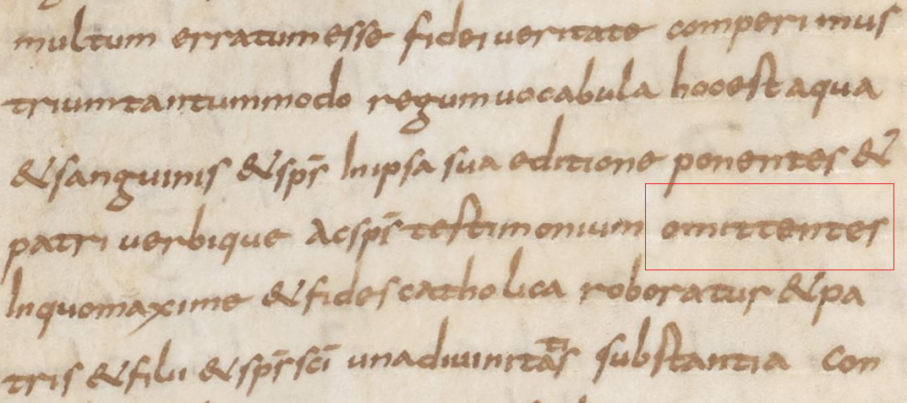
Folio = The manuscript breaks off at 1 Peter 4:3.
https://www.bl.uk/manuscripts/Viewer.aspx?ref=add_ms_24142_fs001r
BnF Latin ms. 1 (circa 9th century A.D.)
https://gallica.bnf.fr/ark:/12148/btv1b8455903b
Folio 377v = Prologue (Anonymous [marginalia possibly refers to Jerome]) reads: “testimonium omittentes” with the “c” erased yet clearly visible, and a marginal note right beside this part of the text about the Comma-J.
https://gallica.bnf.fr/ark:/12148/btv1b8455903b/f762.image


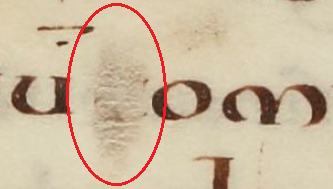
Marginal note:
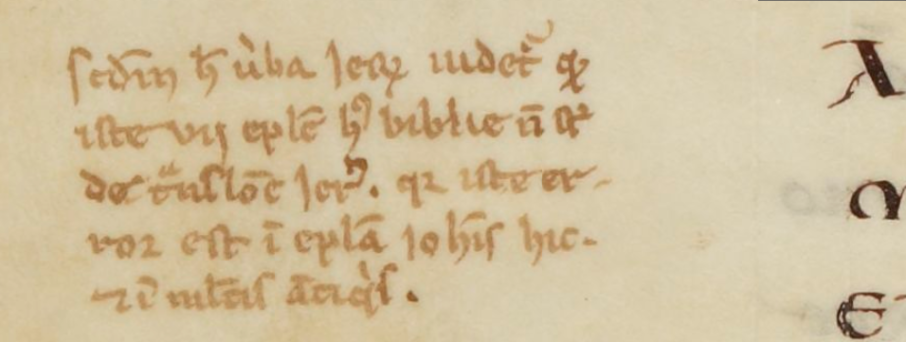
Folio 382r = John 5:7-8, no Comma-J.
https://gallica.bnf.fr/ark:/12148/btv1b8455903b/f771.item.zoom
BNF, Latin ms. 2 (circa. 9th century C.E. [A.D.])
Folio 407v = Prologue (Anonymous) reads: “omittentes” no obvious signs of erasure.
https://gallica.bnf.fr/ark:/12148/btv1b8452767n/f824.item
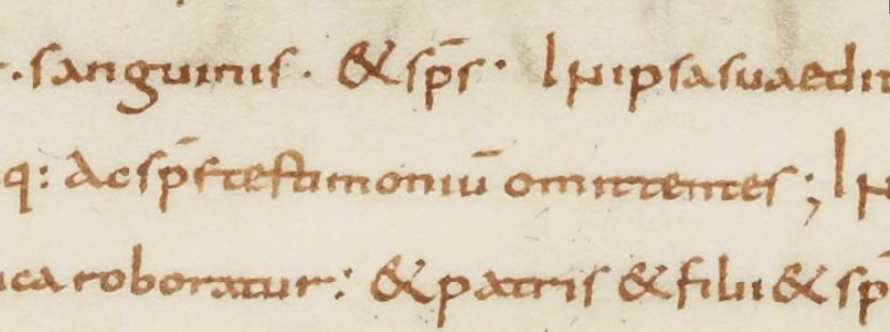
Folio 411v = 1 John begins
https://gallica.bnf.fr/ark:/12148/btv1b8452767n/f832.item
Folio 412v = 1 John 5:7-8, no Comma-J.
https://gallica.bnf.fr/ark:/12148/btv1b8452767n/f834.item.zoom
BnF Latin ms. 3 (circa. 9th century [A.D.] C.E.)
Folio 353v = Prologue (Anonymous) reads: “comittentes” with no signs of tampering.
https://gallica.bnf.fr/ark:/12148/btv1b8426789n/f712.item.zoom


Folio 357r = 1 John begins
https://gallica.bnf.fr/ark:/12148/btv1b8426789n/f719.item
Folio 357v = 1 John 5:7-8, no Comma-J.
https://gallica.bnf.fr/ark:/12148/btv1b8426789n/f720.item
BnF Latin ms. 4, (circa. 9th century A.D.)
Folio 152v = Prologue (Anonymous [a later corrector’s hand attributes to Jerome]) reads: “testimonium ommittentes” with the: “o” in different colored ink to the rest of the word. Above the “o” is an erased: “o” showing “c” must have been in the main text originally. There is heavy signs of erasure all around this part of the text.
https://gallica.bnf.fr/ark:/12148/btv1b84546957/f308.item.zoom
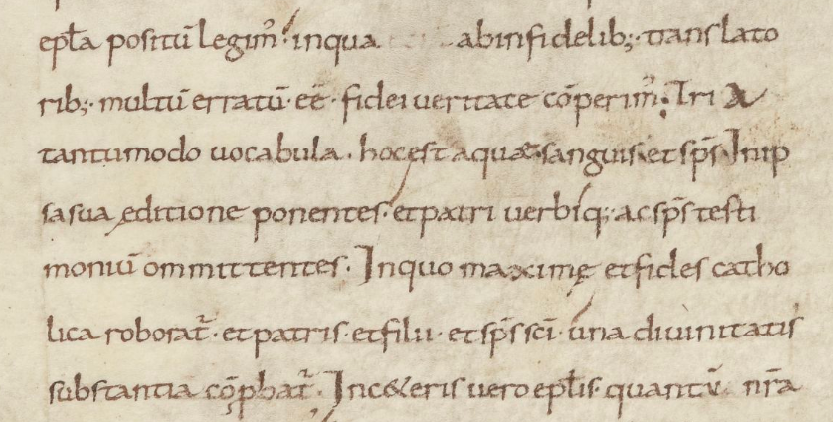


Folio 157v = 1 John 5:7-8, has half of vs 7 erased completely, with an adjacent marginal note with the Comma-J in a later hand with the vairant: “sanguis, aqua, & caro”.
https://gallica.bnf.fr/ark:/12148/btv1b84546957/f318.item.zoom
BnF Latin ms. 47 (circa. 9th century C.E. [A.D.])
Folio 141v = Prologue (Anonymous) reads: “comittentes”
https://gallica.bnf.fr/ark:/12148/btv1b84267909/f290.item


Folio 146v = 1 John 5:7-8, no Comma-J, but marginalia with CJ.
https://gallica.bnf.fr/ark:/12148/btv1b84267909/f300.item.zoom
BnF Latin ms. 111 (circa. 9th century [A.D.] C.E.)
Folio 122r = Prologue (Anonymous) reads: “omittentes” with “c” clearly erased.
https://gallica.bnf.fr/ark:/12148/btv1b8426292d/f251.item.zoom


Folio 125r = 1 John begins
https://gallica.bnf.fr/ark:/12148/btv1b8426292d/f257.item.zoom
Folio 126r = 1 John 5:7-8, no Comma-J, yet has: “[et (?)] terra” extending out into the margin in darker ink, with erasure and evident signs of tampering in this text.
https://gallica.bnf.fr/ark:/12148/btv1b8426292d/f259.item.zoom
BnF Latin ms. 250 (circa. 9th century [A.D.] C.E.)
Folio 61v = Prologue (attrib. to Jerome) reads: “ommittentes” with “c” erased but clearly visible.
https://gallica.bnf.fr/ark:/12148/btv1b84267887/f132.item.zoom



Folio 65v = 1 John begins
https://gallica.bnf.fr/ark:/12148/btv1b84267887/f140.item.zoom
Folio 66v = 1 John 5:7-8, no Comma-J, but a scribal Notae in the margin.
https://gallica.bnf.fr/ark:/12148/btv1b84267887/f142.item.zoom
BNF Latin ms. 13174 (circa. 9th century C.E. [A.D.])
https://gallica.bnf.fr/ark:/12148/btv1b8427447k.r=Latin%2013174?rk=21459;2
Folio 72v = Prologue (attrib. to Jerome) bottom line mentions Johns Epistle
https://gallica.bnf.fr/ark:/12148/btv1b8427447k/f153.item.r=Latin%2013174.zoom
Folio 72r = Prologue continues, reads: “omittentes” with: “c” and: “m” erased but visible where they were.
https://gallica.bnf.fr/ark:/12148/btv1b8427447k/f154.item.r=Latin%2013174.zoom
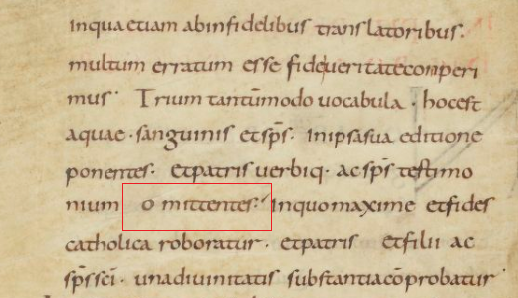


Folio 92r = 1 John begins
https://gallica.bnf.fr/ark:/12148/btv1b8427447k/f193.item.r=Latin%2013174.zoom
Folio 98r = 1 John 5:7-8, no Comma-J in main text, but has Notae, and: “in t[e]r[r]a” above line. Comma-J is written in a marginal note by a later hand.
https://gallica.bnf.fr/ark:/12148/btv1b8427447k/f205.item.r=Latin%2013174.zoom
Folio 139v = three Patristic citations of the CJ. On the same folio I noticed two Pater Noster (aka: “the Lord’s Prayer” literally the: “Our Father” Prayer from Matt. 6:9) references, one of them in very faded ink along side differing variants of the CJ. The Pater Noster references might be an older text than the CJ variants. The Pater Noster in this case, might have acted as a switch, or trigger (mentioned in Grantley McDonald’s “Raising the Ghost of Arius,” Page 38). Matt. 6:9 according to Jerome’s Vulgate reads: “in caelis,” which is very close to: “in caelo” from the CJ. This might have triggered thoughts (i.e. activated the switch from one to the other) about the CJ (or perhaps vice versa) that Grantley McDonald has very astutely observed.
Bibliothèque Carnegie de Reims. Ms. 2 (circa 9th century C.E. [A.D.])
Folio 163v = Prologue (Anonymous) reads: “omittentes” with: “c” clearly erased.
https://gallica.bnf.fr/ark:/12148/btv1b8449583z/f330.item
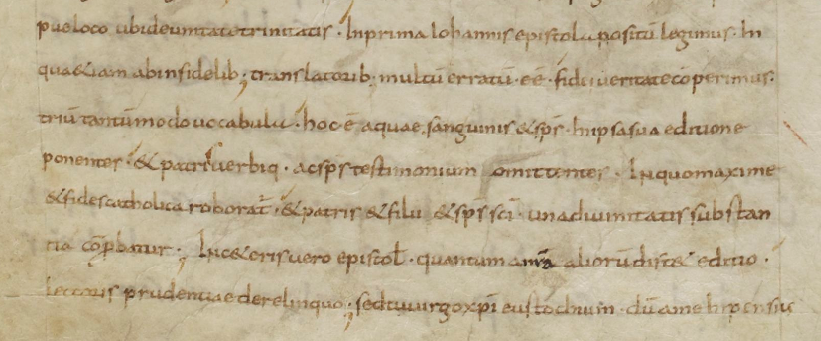


Folio 167v = 1 John begins, and note on 1 John 5:7-8 (no CJ).
https://gallica.bnf.fr/ark:/12148/btv1b8449583z/f338.item.zoom
Folio 168v = 1 John 5:7-8, no Comma-J. But marginalia with CJ cut in half on edge of page.
https://gallica.bnf.fr/ark:/12148/btv1b8449583z/f340.item.zoom
Bamberg, Staatliche Bibliothek, Msc. Bibl. 1. [formerly A.I.5] (circa 9th century A.D.)
Folio 392r = Prologue (Anonymous) reads: “omittentes” with: “c” erased yet still visible.


Folio 396r = 1 John begins
Folio 397r = 1 John 5:7-8, no Comma-J.
https://zendsbb.digitale-sammlungen.de/db/0000/sbb00000032/images/
Karlsruhe, Badische Landesbibliothek, Aug. perg. 185 (circa. 9th century A.D. [C.E.])
https://digital.blb-karlsruhe.de/blbhs/content/zoom/2290270
Folio 77v = Prologue (Anonymous) reads: “committentes” with a spelling correction for “t”.
https://digital.blb-karlsruhe.de/blbhs/content/zoom/2290425


Folio 86r = 1 John begins
Folio 87v = 1 John 5:7-8, no Comma-J, but very messy text with corrections abounding.
https://digital.blb-karlsruhe.de/blbhs/content/zoom/2290445
Codex Fulda. Aa 11 (circa. 9th century C.E.)
Folio 257 = Prologue (attrib. to Jerome) reads: “omittentes” with no signs of correction.

Folio 262v = 1 John 5:7-8, has Comma-J with the comparative variant of: “Sicut in caelo tres sunt” (“just like/as there is/are three in heaven” etc).
https://fuldig.hs-fulda.de/viewer/image/PPN314753974/1/LOG_0003/
St. Gallen, Stiftsbibliothek, Cod. Sang. 63 (circa. 9th century A.D. [C.E.])
Folio 245 = Prologue (attrib. to Jerome) reads: “omittentes” with gaps in the word and signs of heavy correction and/or erasure surrounding that part of the text.
https://www.e-codices.unifr.ch/en/csg/0063//245
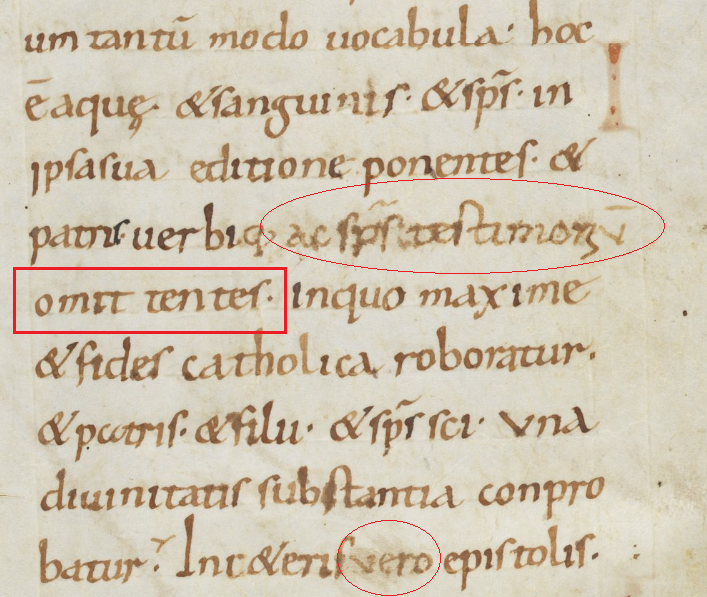
Folio 277 = 1 John 5:7-8, no Comma-J in main text, but a Notae pointing to marginalia at bottom of page with the comparative variant: “Sicut in caelo tres sunt Pater & Verbu[m] & Sp[iritum] S[an]c[tum] & tres unum sunt” (“just like/as there is/are three in heaven” etc).
https://www.e-codices.unifr.ch/en/csg/0063//277
https://www.e-codices.unifr.ch/en/description/csg/0063/Scherrer
10th century C.E. Vulgate manuscripts containing the CE-Prol.
Bern, Burgerbibliothek, Cod. A 9 (circa. 10th century C.E.)
Folio 303v = Prologue (Anonymous [added in a different/later hand attrib. Jerome]) reads: “omittentes” with: “c” erased and still visible.
https://www.e-codices.unifr.ch/en/bbb/A0009/303v



Folio 307r = 1 John 5:7-8, no Comma-J, but a later ahnd has put: “in t[e]r[r]a” above the line, and a scribal Notae pointing to bottom marginalia which has the Comma-J “& Filius” varriant.
https://www.e-codices.unifr.ch/en/bbb/A0009/307r/0/Sequence-44
BnF Latin ms. 6 [Codex Rodensis] (circa 10th century C.E. [A.D.])
Folio 67v = Prologue (attrib. to Jerome), reads: “comittetes” with what appears to be a spelling mistake.
https://gallica.bnf.fr/ark:/12148/btv1b8538814d/f140.item.zoom
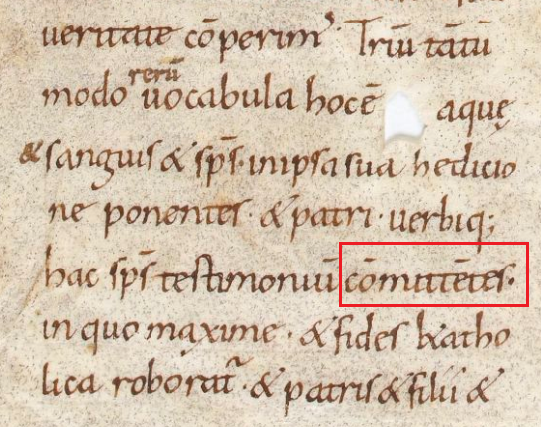


Folio 73r = 1 John 5:7-8, no Comma-J. But has a marginal note containing the standard CJ.
http://gallica.bnf.fr/ark:/12148/btv1b8538814d/f151.item.zoom
Cava de’ Trirrenei, Biblioteca statle del Monumento nazionale della Abbazia Benedettina della Ss. Trinita, Codices Cavenses, Cod. 1 Biblio Sacra [Codex Cavensis] (circa. 10th century C.E. [A.D.])
Folio 273r = Prologue (attrib. to Jerome) reads: “conmittentes” with the alternative spelling “n” (comp. Toletanus).
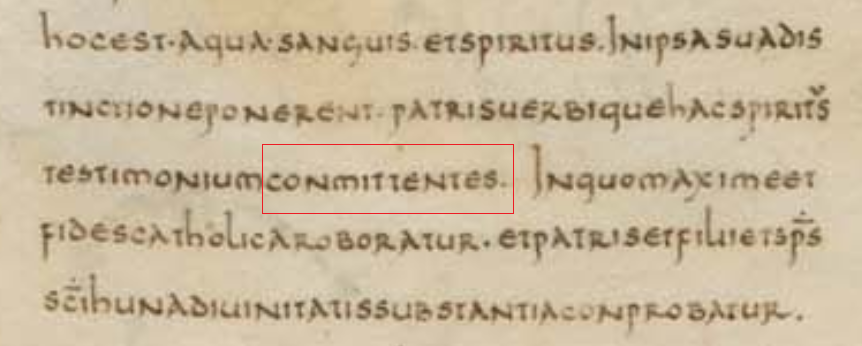

Folio 276v = 1 John 5:7-8, has Comma-J. Variant reading: “in Christ Jesus” (comp. Toletanus).
Toledo, Catedral, Biblioteca del Cabildo, 35–8 [Codex Toletanus] (circa 10th century C.E. [A.D.])
Folio 352 (700 PDF) = Prologue (attrib. to Jerome) reads: “conmittentes” also with an: “n” (comp. Cavensis).
http://bdh-rd.bne.es/viewer.vm?id=0000022964


Folio 355 (707 PDF) = 1st John starts:
http://bdh-rd.bne.es/viewer.vm?id=0000022964
Folio 357 (710 PDF) = 1st John 5:7-8, has Comma-J. Variant reading: “in Christ Jesus” (comp. Cavensis).
http://bdh-rd.bne.es/viewer.vm?id=0000022964
11th century Vulgate manuscripts
From the 11th century on-wards Latin: “omittentes”, plus slight variants such as: “omittens,” or as in one 12th century Ms: “omittentibus”, become the more consistent reading. So I’m not going to bother posting all of these (takes so much time).
12th century Vulgate manuscripts
Vatican Manuscript-Arch.Cap.S.Pietro.A.1 (circa. 12th century C.E. [A.D.])
Folio 373r = Prologue (Anonymous) reads: “comittentes”.
https://digi.vatlib.it/view/MSS_Arch.Cap.S.Pietro.A.1
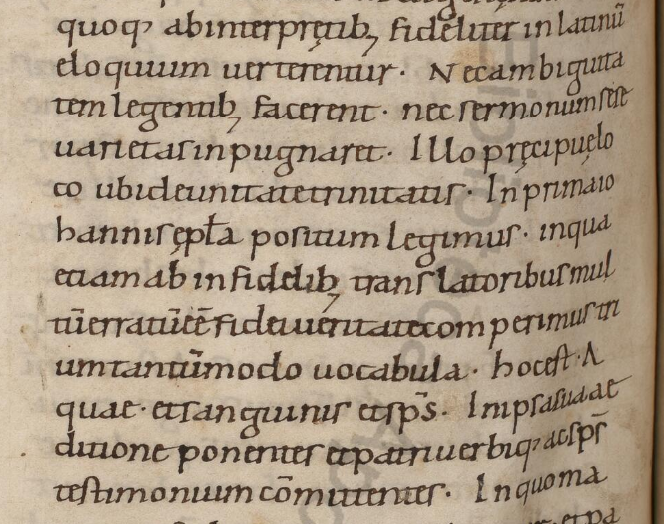

Folio 379r = has Comma-J
https://digi.vatlib.it/view/MSS_Arch.Cap.S.Pietro.A.1
British Library, Harley, MS 2834 (circa. 12th century C.E. [A.D.])
Folio 215r = Prologue (Anonymous) reads: “omitten-tibus”.
https://manuscrits-france-angleterre.org/view3if/pl/ark:/81055/vdc_100059312949.0x000001/f435
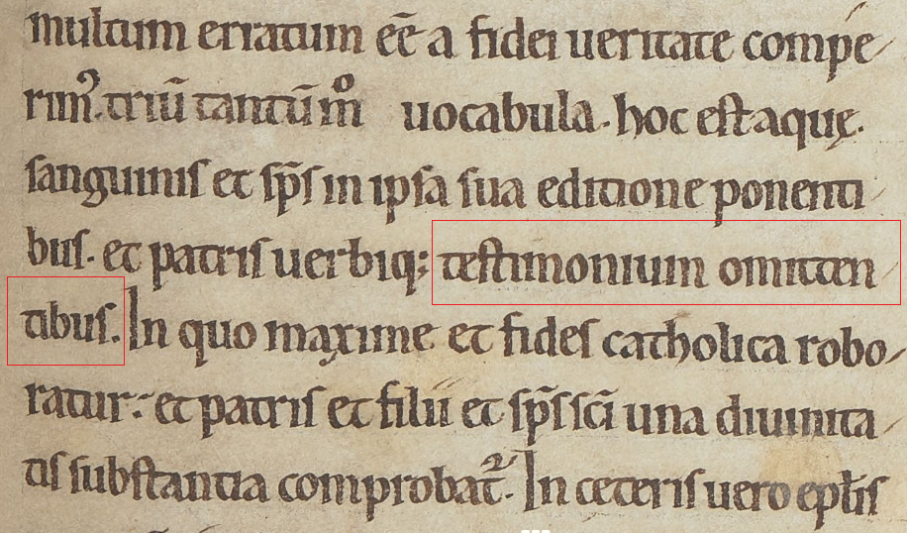
Folio 221r = has Comma-J.
https://manuscrits-france-angleterre.org/view3if/pl/ark:/81055/vdc_100059312949.0x000001/f446
13th century Vulgate manuscripts
14th century Vulgate manuscripts
15th century Vulgate manuscripts
16th century Vulgate manuscripts
I randomly looked at a 16th century manuscript (I didn’t think any MS after the advent of printing would still have the original reading) but remarkably one still has the reading: “comittentes”. There might be other late manuscripts with this reading, but it’s the oldest ones that are the most important.
Vat. Lat. 4221 (circa. 16th century C.E. [A.D.])
Folio 148r = Prologue (attrib. to Jerome) reads: “comittentes”.
https://digi.vatlib.it/view/MSS_Vat.lat.4221
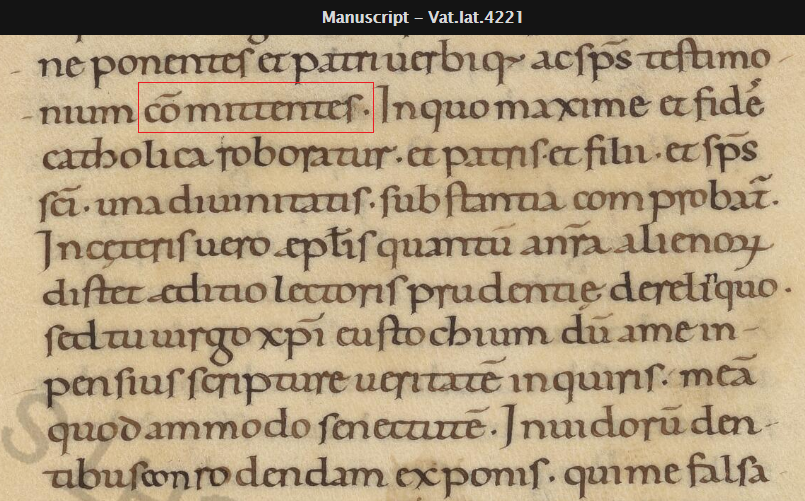
Folio 152r = 1 John begins.
https://digi.vatlib.it/view/MSS_Vat.lat.4221
Folio 153r = 1 John 5:7-8, has Comma-J.
https://digi.vatlib.it/view/MSS_Vat.lat.4221
Please bear in mind that my research is not exhaustive (by any means).
It appears that although some of the big players in the CJ-controversy must have had access to Vulgate manuscripts (men such as Erasmus, Sir Issac Newton, and their Pro-CJ opponents, etc), yet from what I can find, (among English writers at least) they:
- Do not appear to have published anything on this reading, or
- Were not aware of it.
When I searched online for the phrase: “testimonium committentes” nothing came up from manuscripts themselves. Some will scoff at this, but I used Steven Avery’s extensive online “Pure-Bible Forum” bibliography’s (S. Avery is a Pro-CJ and KJV-Only advocate) about the CJ-controversy. Though partially useful, I found no reference at all to this reading, by Avery, Maynard, or anyone else [NOTE: (03/03/20) I am now aware by his comments below, that he has since read this post] either Pro-CJ or against CJ.
In modern times (to my current knowledge at least) Daniel Wallace, Hugh Houghton, Grantley McDonald, Bruce Metzeger, Brown, Walter Thiele, say (or said – Thiele and Metzeger now disceased) nothing about this reading. So, unless someone kindly brings something to my attention that I’ve missed, I (for the time being at least) conclude that they were not aware of it [NOTE: (03/03/20) Since publishing this post I have had personal correspondence with some of these, and one of them (Hugh Houghton) was aware of this reading (will comment on this in a new Blog post later). Some were not aware of the above “commitentes” Fuldensis reading (and the other CE-Prol manuscripts) until I brought it to their attention].
The older writers (Newton etc) only appear to know: “testimonium omittentibus” in the CE-Prol. Below are some random examples from a Google search:
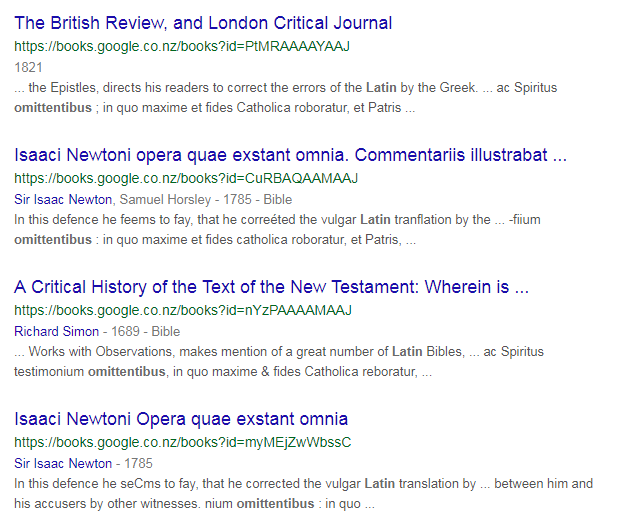
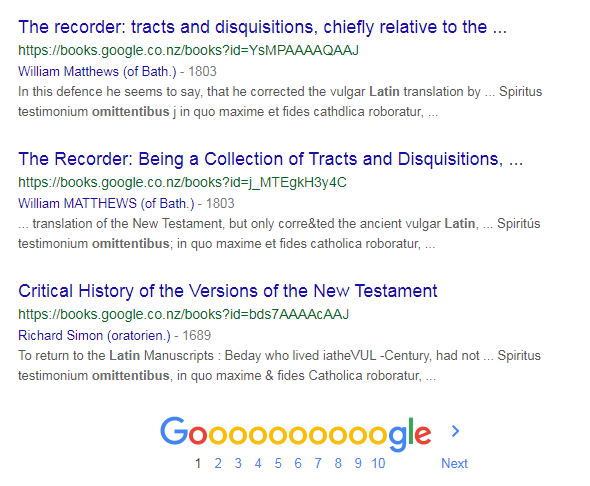
Lastly, in addition to all of the above, please remember that there is a real:
- textual incompatibility and
- logical discrepency
In the Codex Fuldensis – if – Jerome was the original author of both the Prologue and the Vulgate reading itself. For there is no Comma Johanneum in this manuscript at 1 John 5:7-8! Also, there are no marginal comments by the original writer (i.e. Victor Caupa), or any Latin Scribal Notae, by medieval Correctors in this manuscript beside/at 1 John 5:6-8.
Take a look!
1st John 5:7-8 Codex Fuldensis = Folio 929:463r
http://fuldig.hs-fulda.de/viewer/fullscreen/PPN325289808/929/
http://fuldig.hs-fulda.de/viewer/image/PPN325289808/929/
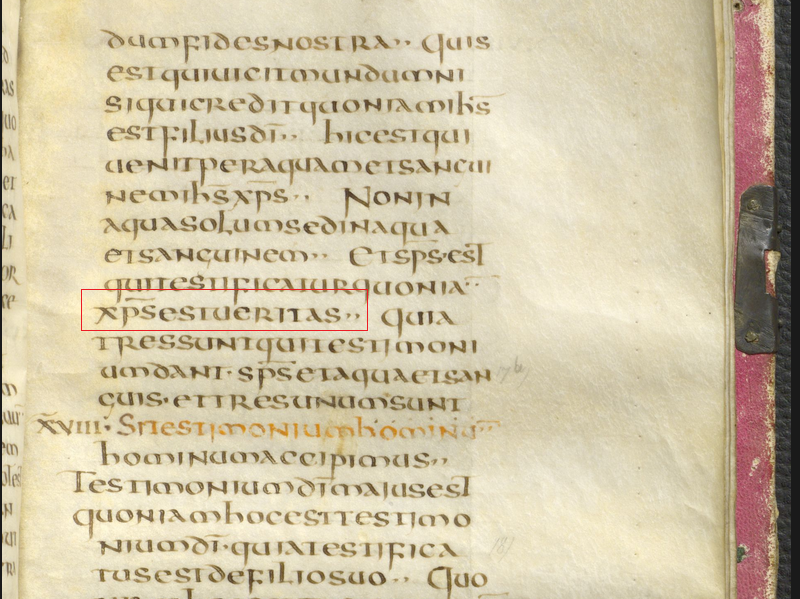
A little closer:

Oh wait, there is one exception, but of no textual value at all. Someone in recent times with a pencil has written in modern English: (7a) possibly corrected to (7v) [i.e. seventh “verse”], and a little further down has also written (8) with the brackets.
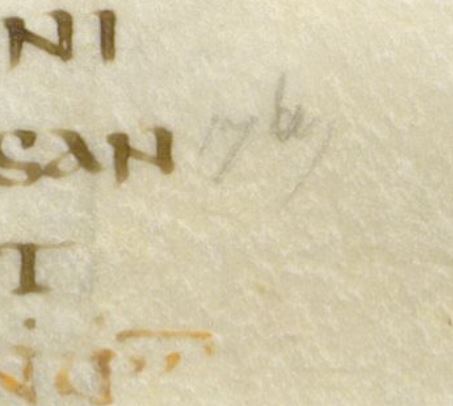
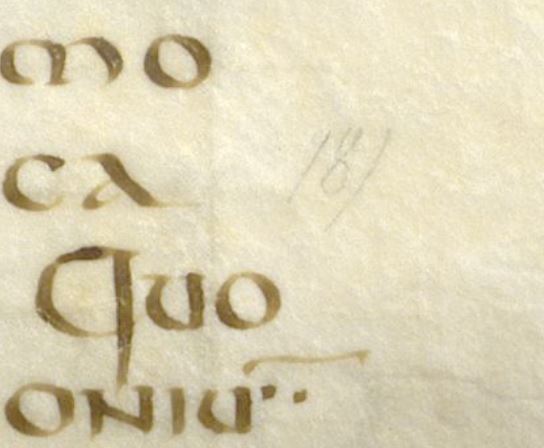
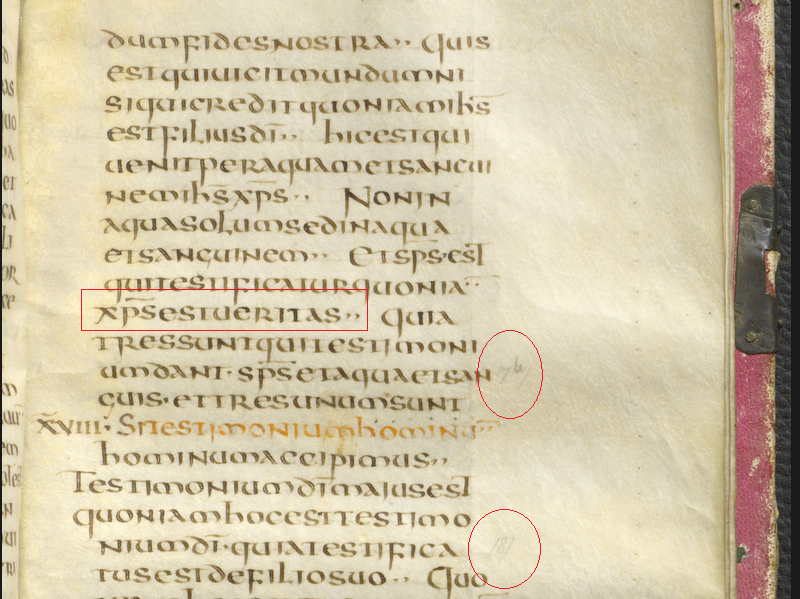
These have no more textual value than if I was to wright them tomorrow in the Fuldensis.
So again (to make the point) there is a real:
- textual incompatibility and
- logical discrepency
In the Codex Fuldensis (thee oldest known extant Ms., of the Vulgate) – if – Jerome was the publisher of both the Prologue and the original Vulgate reading itself.
That is the evidence (empirical evidence contra anecdotal) as it stands.
So!
Please excuse the font sizes and rough appearance of the post. I just want to get this online as quickly as possible [when originally posted].
If you have any useful, specific, detailed information that you possess, or have found on this particular reading (i.e. “committentes”) in the Fuldensis manuscript itself, (or on other variants of “committentes” in the early Vulgate CE-Prol Ms., not mentioned here = perhaps with images/links etc) please feel free to share them in the comments section below. But if you want to post off-topic irelavent information – then please refrain – from commenting. Otherwise, your comments will be deleted.
P.S. This post may be updated as more information comes to hand. Additionally, another updated post on this prologue is on the cards.

Victor servant of Christ and of his grace bishop of Capua, I read (this) on 6th day before the Nones of May, d (?) indiction nine, 15 pc ? of Basil, (vir clarissimus) cs?
LikeLike
Thanks for the translation.
LikeLike
Committentes, “bring together, unite/join, connect/attach; put together, construct; entrust;”… include would be a possible meaning perhaps?
LikeLike
Plural, present, active, participle of Latin “committo”.
Possible renderings: “they commit” or perhaps: “they are perpetrating” “they are commencing” “they begin” etc. Most of all, whatever the translation, it will have to fit the over-all context.
http://latin-dictionary.net/definition/11466/committo-committere-commisi-commissus
https://en.wiktionary.org/wiki/committo
https://en.wiktionary.org/wiki/committente
https://latin.cactus2000.de/showverb.en.php?mob=1&verb=committere&gen=2&voc=2
https://latinlexicon.org/definition.php?p1=2011807
LikeLike
Hi Steven.
I’d like your opinion on the original Fuldensis manuscript reading: “committentes”? Also on the erasing of: “committentes” in all these other different manuscripts with such diverse geographical distribution and backgrounds?
Why do you think the later copyists were uncomfortable with Jerome’s original text?
What do you think: “committentes” means in the original context?
How would you translate: “committentes” in the context?
Because getting the author’s original meaning in the Prologue (rather than substitute/censored readings from a different age), is really what this post is about (not the CJ-text itself or even Patristic readings elsewhere). What is really important is getting the original thought (no matter how awkward) that Jerome was originally conveying by the word: “commitentes” (before edited and corrected)? Can I be any clearer?
Otherwise, Steven, refrain from posting, please.
LikeLike
Your interesting observation raises many questions about the practices of the editors of this text in the past. That they should have missed this reading in so many manuscripts staggers belief.
However, I doubt that “committentes” is the correct reading. The author – incidentally, I don’t believe that it was Jerome – claims that some scribes or translators write down (“ponentes”) the water, spirit and blood, but miss out the Father, Word and Spirit. The only possible sense I can wrest from “committentes” is that some scribes or translators “commit to writing” the testimony of the Father, Word and Spirit. “Committentes” would thus mean the same thing as “ponentes” – but then of course the author’s pointed contrast disappears. He is unhappy that some authors leave out the Father, Word and Spirit, not that they also commit these words to the page. Arguing simply from the sense of the passage, I think “omittentes” must be the correct reading.
There are several possible ways in which the “o-” could have been read as “com-”. Once this had happened in one manuscript copy, it was likely transmitted to further copies unless later scribes intervened. It would be interesting to trace the variants in the entire text of the prologue in the various manuscripts to see if this variant could be isolated to a particular textual family. Of course, such an error could have happened independently more than once.
Firstly, the “c-” might have crept in through visual similarity with the “o-”. But this still leaves some details unexplained.
Alternatively, it is possible that Fuldensis (or its archetype) was copied from a defective exemplar in which this word was illegible or damaged (a real possibility if the archetype was written on papyrus). The scribe of Fuldensis might then simply have guessed at the missing letter or letters.
A third possibility is perhaps the most plausible: it is possible that an early scribe mistook the “o” for an abbreviation. The Tironian sign for “con-” or “com-”, preserved as an abbreviation in many different kinds of Latin hands through the middle ages, looks like a reversed “c”, which is easily confused with an “o”. (See Ulrich Friedrich Kopp, Tachygraphia veterum 2 [= Palaeographia critica vol. 2.2], p. 52). This would explain the misreading quite economically.
Then, as you have shown in some of the manuscripts, some later readers corrected “committentes” to “omittentes”, because they clearly realised that “committentes” just doesn’t make a whole lot of sense.
I’m so glad that you brought this to our collective attention. Even if we seem to be dealing with a rogue reading, you are quite right to ask what the absence of this variant from any critical edition says about editorial standards in the past. It is possible that the judgement of the editors of yesteryear was compromised by short library opening hours, poor lighting or failing eyesight. (Those filthy splotches in Fuldensis are caused by a reagent used in the nineteenth and early twentieth century to bring out faded letters, which shows that an early editor was really struggling to read this page.) However this oversight might have happened, I hope your discoveries encourage us to do better in the future.
Grantley McDonald
LikeLike
Hi Grantley.
Thank you for your well-researched comments. I will have to make another post to address your’s and Hugh Houghtons points. Must state again, I love your book and research papers on the CJ.
Got to go sorry.
Kind regards.
Matt13weedhacker.
LikeLike
This really much ado about nothing. If you look carefully at the word TESTIMONIUM before COMMITTENTES, you will notice it is missing the [ m ]. The scribe seems to have botched the [ m ] on the following line and just kept going. Secondly, COMMITTENTES makes for very awkward and suspicious choice of wording given the context. It seems that scribes then did what scribes have been known to do throughout history—copy everything as you see it, hence why it is in so many manuscripts…
LikeLike
Is “committentes” is the original wording? What could “committentes” possibly mean in this context? How did it get there in the first place? That’s up to you to decide. All I can say is, I’ve found even more evidence of erasure and retro-editing in more manuscripts since posting this blog.
LikeLike
Very nice find! The evidence is clear that some tampering as happened with this prologue.
Something else that your list of English translations missed, is the Latin phrase “ipsa sua editione potentes” which is something like “in themselves a powerful statement”. So that in all the translation should be roughly like this in my view:
“…unfaithful translators have errored a lot from the truth of the faith, have been found only three words, that is of water, blood and of spirit – in themselves a powerful statement – and the testimony of the father, word, and spirit they have committed/added/joined.”
This makes a significant difference, and says the complete opposite of what English translators have said. If the author is saying the unfaithful translators have ADDED the phrase “father, word and spirit”, this matches with Codex Fuldensis in omitting the CJ from 1 John – it solves the contradiction between the prologue and the verse.
‘committentes’ is exactly the same grammatically as ‘omittentes’ – so the grammar of the sentence is not altered at all by the swapping of two, it only changes the meaning.
LikeLike